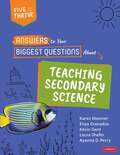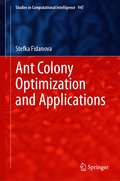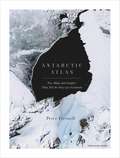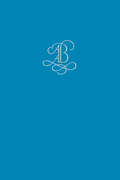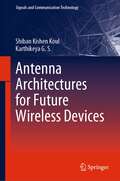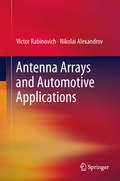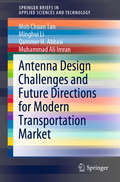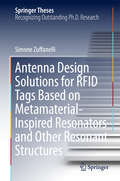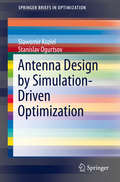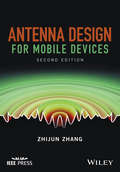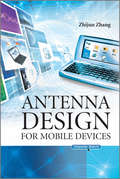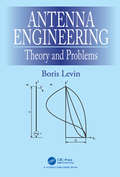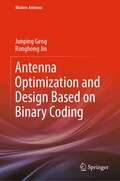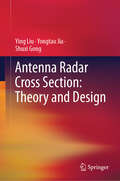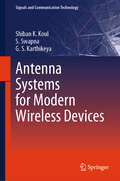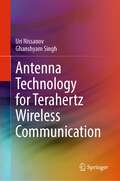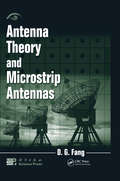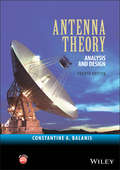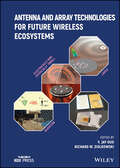- Table View
- List View
Answers to Your Biggest Questions About Teaching Secondary Science: Five to Thrive [series]
by Ayanna D. Perry Karen Mesmer Enya Granados Kevin Gant Laura ShaferYour guide to grow and flourish as a science teacher! The past two decades have seen a paradigm shift in science education, thanks in large part to the Next Generation Science Standards (NGSS), which advocate a move away from procedural lab investigations and direct instruction and toward increased emphasis on reasoning, sensemaking, phenomena exploration, problem solving, and collaboration. Under this new paradigm, students are learning real science as scientists practice it, so that more and more students are actively investigating questions and pursuing solutions of their own making. As part of the Five to Thrive series for early-career educators, this comprehensive guide provides those who are new to teaching science, as well as seasoned teachers looking to enhance their practice, the fundamentals to develop best teaching practices that reflect their students’ experiences and requirements. Written by experienced science educators, Answers to Your Biggest Questions About Teaching Secondary Science provides practical guidance on successful strategies and techniques for teaching science in a way that gives every student the opportunity to learn, grow, and achieve at high levels, while providing opportunities to develop their agency and authority in the classroom, ultimately resulting in a positive science identity. The book is organized around five overarching questions and answers that will help you most thrive in your secondary science classroom: How do I build a positive science community? How do I structure, organize, and manage my science class? How do I engage my students in science? How do I help my students talk about science? How do I know what my students know and how can I use that information to plan and move them forward? The book concludes with a sixth question—Where do I go from here?—that provides guidance for growing your practice over time, including discussions on self-care, advocating for students, and an extensive discussion on growing your professional network. Woven throughout, you′ll find helpful sidebar notes on fostering identity and agency; access and equity; teaching in different settings; and invaluable resources for deeper learning.Strive to become the best science educator you can be; your students are counting on it!
Answers to Your Biggest Questions About Teaching Secondary Science: Five to Thrive [series]
by Ayanna D. Perry Karen Mesmer Enya Granados Kevin Gant Laura ShaferYour guide to grow and flourish as a science teacher! The past two decades have seen a paradigm shift in science education, thanks in large part to the Next Generation Science Standards (NGSS), which advocate a move away from procedural lab investigations and direct instruction and toward increased emphasis on reasoning, sensemaking, phenomena exploration, problem solving, and collaboration. Under this new paradigm, students are learning real science as scientists practice it, so that more and more students are actively investigating questions and pursuing solutions of their own making. As part of the Five to Thrive series for early-career educators, this comprehensive guide provides those who are new to teaching science, as well as seasoned teachers looking to enhance their practice, the fundamentals to develop best teaching practices that reflect their students’ experiences and requirements. Written by experienced science educators, Answers to Your Biggest Questions About Teaching Secondary Science provides practical guidance on successful strategies and techniques for teaching science in a way that gives every student the opportunity to learn, grow, and achieve at high levels, while providing opportunities to develop their agency and authority in the classroom, ultimately resulting in a positive science identity. The book is organized around five overarching questions and answers that will help you most thrive in your secondary science classroom: How do I build a positive science community? How do I structure, organize, and manage my science class? How do I engage my students in science? How do I help my students talk about science? How do I know what my students know and how can I use that information to plan and move them forward? The book concludes with a sixth question—Where do I go from here?—that provides guidance for growing your practice over time, including discussions on self-care, advocating for students, and an extensive discussion on growing your professional network. Woven throughout, you′ll find helpful sidebar notes on fostering identity and agency; access and equity; teaching in different settings; and invaluable resources for deeper learning.Strive to become the best science educator you can be; your students are counting on it!
Ant Colony Optimization and Applications (Studies in Computational Intelligence #947)
by Stefka FidanovaThis book is interesting and full of new ideas. It provokes the curiosity of the readers. The book targets both researchers and practitioners. The students and the researchers will acquire knowledge about ant colony optimization and its possible applications as well as practitioners will find new ideas and solutions of their combinatorial optimization and decision-making problems. Ant colony optimization is between the best method for solving difficult optimization problems arising in real life and industry. It has obtained distinguished results on some applications with very restrictive constraints. The reader will find theoretical aspects of ant method as well as applications on a variety of problems. The following applications could be mentioned: multiple knapsack problem, which is an important economical problem; grid scheduling problem; GPS surveying problem; E. coli cultivation modeling; wireless sensor network positioning; image edges detection; workforce planning.
Antarctic Atlas: New Maps and Graphics That Tell the Story of A Continent
by Peter FretwellA FINANCIAL TIMES BOOK OF THE YEAR 2020SHORTLISTED FOR THE ESTWA AWARD FOR ILLUSTRATED TRAVEL BOOK OF THE YEAR 2022One of the least-known places on the planet, the only continent on earth with no indigenous population, Antarctica is a world apart. From a leading cartographer with the British Antarctic Survey, this new collection of maps and data reveals Antarctica as we have never seen it before.This is not just a book of traditional maps. It measures everything from the thickness of ice beneath our feet to the direction of ice flows. It maps volcanic lakes, mountain ranges the size of the Alps and gorges longer than the Grand Canyon, all hidden beneath the ice. It shows us how air bubbles trapped in ice tell us what the earth's atmosphere was like 750,000 years ago, proving the effects of greenhouse gases. Colonies of emperor penguins abound around the coastline, and the journeys of individual seals around the continent and down to the sea bed in search of food have been intricately tracked and mapped. Twenty-nine nations have research stations in Antarctica and their unique architecture is laid out here, along with the challenges of surviving in Antarctica'sunforgiving environment.Antarctica is also the frontier of our fight against climate change. If its ice melts, it will swamp almost every coastal city in the world. Antarctic Atlas illustrates the harsh beauty and magic of this mysterious continent, and shows how, far from being abstract, it has direct relevance to us all.
Antarctic Futures: Human Engagement with the Antarctic Environment
by Machiel Lamers Tina Tin Daniela Liggett Patrick T MaherAt the beginning of the 21st century, Antarctica is poised at the edge of a warmer and busier world. Leading Antarctic researchers examine the needs and challenges of Antarctic environmental management today and tomorrow. Through: (i) investigating the impacts of human activities on specific ecosystems and species, (ii) examining existing environmental management and monitoring practices in place in various regions and (iii) interrogating stakeholders, they address the following questions: What future will Business-As-Usual bring to the Antarctic environment? Will a Business-As-Usual future be compatible with the objectives set out under the Antarctic Treaty, especially its Protocol on Environmental Protection? What actions are necessary to bring about alternative futures for the next 50 years? This volume is an outcome of the International Polar Year (2007-2009) Oslo Science Conference (8-12, June, 2010).
Antarctic Glacial History and World Palaeoenvironments
by E.M. van Zinderen BakkerThis book, based on the proceedings of third symposium held on 17th August 1977 during the Xth INQUA Congress at Birmingham, UK, focuses on the influence the Antarctic glaciation had on world palaeoenvironments.
Antarctic Peninsula & Tierra del Fuego: Proceedings of "Otto Nordensjold's Antarctic Expedition of 1901-1903 and Swedish Scientists in Patagonia: A Symposium", Buenos Aires, Argentina, March 2-7, 2003
by Jorge Rabassa María Laura BorlaThis symposium, held in Argentina in March 2003, commemorates Otto Nordenskjold's 1901 expedition, and pays tribute to the Swedish and Argentinian explorers who took on the challenge of early fieldwork in Patagonia and Antarctica. This theme is extended to include recent fieldwork in the natural sciences in the Archipelago of Tierra del Fuego, the
Antarctic Whaling: A Case Study in Near Extinction
by John Sheail Paul Rodhouse John DudeneyAntarctic Whaling explores how British whalers came to claim so large a share of the whales taken from the Southern Ocean in the first half of the twentieth century, and, more particularly, where, when, how and why the British Government came to play so large a part in whaling history through its endeavour to regulate the whaling grounds.
Antenna Architectures for Future Wireless Devices (Signals and Communication Technology)
by Shiban Kishen Koul Karthikeya G. S.This book presents the design requirements of antenna integration for modern commercial devices such as smartphones, dongles, and access points. Practical use-case scenarios of smartphone and the design process of the antenna system for the same are highlighted. The feasibility of scaling up sub-6GHz to mmWave antennas is also discussed in detail followed by a plethora of design examples which could be panel mounted to modern-day commercial smartphones. The unique requirement of gain switchability is introduced with feasible practical antenna designs. High efficiency antennas for 5G base stations is introduced along with a design example on planar all-metallic antenna. Beam switchability requirement for base station is illustrated with a couple of compact antenna system examples. Variety of feeding techniques for mmWave antennas is elaborated in this book. Finally, low-cost antenna designs for future wireless devices are illustrated.
Antenna Arrays and Automotive Applications
by Nikolai Alexandrov Victor RabinovichThis book throws a lifeline to designers wading through mounds of antenna array patents looking for the most suitable systems for their projects. Drastically reducing the research time required to locate solutions to the latest challenges in automotive communications, it sorts and systematizes material on cutting-edge antenna arrays that feature multi-element communication systems with enormous potential for the automotive industry. These new systems promise to make driving safer and more efficient, opening up myriad applications, including vehicle-to-vehicle traffic that prevents collisions, automatic toll collection, vehicle location and fine-tuning for cruise control systems. This book's exhaustive coverage begins with currently deployed systems, frequency ranges and key parameters. It proceeds to examine system geometry, analog and digital beam steering technology (including "smart" beams formed in noisy environments), maximizing signal-to-noise ratios, miniaturization, and base station technology that facilitates in-car connectivity while on the move. An essential guide for technicians working in a fast-developing field, this new volume will be warmly welcomed as a powerful aid in their endeavors.
Antenna Design Challenges and Future Directions for Modern Transportation Market (SpringerBriefs in Applied Sciences and Technology)
by Muhammad Ali Imran Qammer H. Abbasi Moh Chuan Tan Minghui LiThis book is focused on wireless infrastructure deployment in modern transportation markets, where the wireless infrastructure co-exists with the existing structure. It details the challenges this deployment may face and explores the mitigation measures to overcome the challenges. The book proposes a smart antenna structure to overcome airspace congestion, which improves the overall wireless performance and deployment cost. With the combination of practical know-how and theoretical estimation, this book provides insight on how the modern smart antenna techniques that support most cutting-edge wireless technology can be adopted into the existing infrastructure whilst minimising the distraction to the existing system. This book is suitable for industrial and academic researchers, practising engineers within the field of smart antennae, and wireless infrastructure designers and developers.
Antenna Design Solutions for RFID Tags Based on Metamaterial-Inspired Resonators and Other Resonant Structures (Springer Theses)
by Simone ZuffanelliThis book describes innovative design solutions for radio-frequency identification (RFID) tags and antennas. Focusing mainly on passive ultra-high-frequency (UHF)-RFID tag antennas, it examines novel approaches based on the use of metamaterial-inspired resonators and other resonant structures as radiating elements. It also offers an exhaustive analysis of the radiation properties of several metamaterial-inspired resonators such as the split ring resonator (SRR) and related structures. Further, it discusses in detail an innovative technology for the RFID tagging of optical discs, which has demonstrated a significant improvement over the state of the art and resulted in a patent. By covering the entire research cycle of theory, design/simulation and fabrication/evaluation of RFID tags and antennas, while also reporting on cutting-edge technologies, the book provides graduate students, researchers and practitioners alike with a comprehensive and timely overview of RFID systems, and a closer look at several radiating structures.
Antenna Design by Simulation-Driven Optimization (SpringerBriefs in Optimization)
by Slawomir Koziel Stanislav OgurtsovThis Brief reviews a number of techniques exploiting the surrogate-based optimization concept and variable-fidelity EM simulations for efficient optimization of antenna structures. The introduction of each method is illustrated with examples of antenna design. The authors demonstrate the ways in which practitioners can obtain an optimized antenna design at the computational cost corresponding to a few high-fidelity EM simulations of the antenna structure. There is also a discussion of the selection of antenna model fidelity and its influence on performance of the surrogate-based design process. This volume is suitable for electrical engineers in academia as well as industry, antenna designers and engineers dealing with computationally-expensive design problems.
Antenna Design for Mobile Devices
by Zhijun ZhangExpanded and updated, this practical guide is a one-stop design reference containing all an engineer needs when designing antennas Integrates state-of-the-art technologies with a special section for step-by-step antenna design Features up-to-date bio-safety and electromagnetic compatibility regulation compliance and latest standards Newly updated with MIMO antenna design, measurements and requirements Accessible to readers of many levels, from introductory to specialist Written by a practicing expert who has hired and trained numerous engineers
Antenna Design for Mobile Devices (Wiley - IEEE)
by Zhijun ZhangWritten by an antenna engineer turned professor who has worked at Apple, Nokia and Amphenol, Antenna Design for Mobile Devicesis a comprehensive guide for fresh and intermediate engineers involved in antenna design. The book instructs readers through all aspects of real world antenna designs, which includes how to make a stable antenna fixture, designing various types of antennas, designing an antenna with good manufacturability, using various matching technique to improve antenna performance, setting up production measurement for mass manufacturing, and making antenna SAR and HAC compliant. Most popular antenna categories, such as internal PIFA, integral IFA, internal folded monopole, ceramic antennas, stubby antennas and whip stubby antennas, are introduced in the book. The book focuses on the basic principle of each kind of antenna and emphasizes on key parameters of antenna optimization. Complimentary matching software, which accompanies the book, is provided so readers can practice various antenna matching technique and design matching circuits for real projects. A one-stop design reference containing all an engineer needs when designing antennas Accessible to readers of many levels, from introductory to specialist Presents shortcuts for engineers who lack antenna knowledge but need no-hassle techniques for designing simple antennas Contains hands-on knowledge not available in other books Written by a practicing expert who has hired and trained numerous engineers Incorporates the various techniques used by pure-play antenna firms, established mobile device brands, and new entrants to the mobile space Comes with antenna matching software written by the author, which can be used for practice and real-world projects Presentation slides with lecture notes available for instructor use This book is targeted at practicing antenna engineers, particularly those focusing on mobile devices, as well as researchers and academics looking to keep up with this quick-changing field. Engineering managers will find it to be a helpful guide for teaching new hires, while new hires, by using the book themselves, will be able to quickly gain expert-level proficiencies. The book is also suitable for wireless network equipment engineers, who desire a stronger sense of antenna principles, as well as electronic engineering students studying electromagnetics. Readers should possess a basic undergraduate-level understanding of electromagnetic theory. Companion website for the book: http://www.wiley.com/go/zhangantenna
Antenna Engineering: Theory and Problems
by Boris LevinThe book deals with theoretical and experimental research of antennas. The presentation is based on the electromagnetic theory. It begins with the theory of thin antennas. Thin antennas represent one of the main types of radiators, thus the theory of thin antennas is the basis of the antennas analysis. Special attention is paid to the integral equation of Leontovich-Levin for a current along a straight thin-walled metal cylinder, which is equivalent to the equation of Hallen with a precise kernel. Together with the analysis of various types of antennas, the book deals with the problems of synthesis including the creation a wide-band radiator by means of determining of the types and the magnitudes of concentrated loads, which are connected along a linear radiator and create in a given frequency band high electrical performance. Problems of antenna engineering are discussed in the second half of the book, including the results of application of a compensation method for the protection of humans against irradiation and structural features of ship antennas.
Antenna Fundamentals for Legacy Mobile Applications and Beyond
by Jonathan Rodriguez Issa Elfergani Abubakar Sadiq Hussaini Raed Abd-AlhameedThis book highlights technology trends and challenges that trace the evolution of antenna design, starting from 3rd generation phones and moving towards the latest release of LTE-A. The authors explore how the simple monopole and whip antenna from the GSM years have evolved towards what we have today, an antenna design that is compact, multi-band in nature and caters to multiple elements on the same patch to provide high throughput connectivity. The scope of the book targets a broad range of subjects, including the microstrip antenna, PIFA antenna, and the monopole antenna to be used for different applications over three different mobile generations. Beyond that, the authors take a step into the future and look at antenna requirements for 5G communications, which already has the 5G drive in place with prominent scenarios and use-cases emerging. They examine these, and put in place the challenges that lie ahead for antenna design, particularly in mm-Wave design. The book provides a reference for practicing engineers and under/post graduate students working in this field.
Antenna Optimization and Design Based on Binary Coding (Modern Antenna)
by Junping Geng Ronghong JinThis book investigates in detail the antenna optimization method with binary coding and their applications to antenna design. It introduces the binary coding principle and optimization method, the method of binary coding corresponding to geometry structure. In further, the designs by binary coding optimization method of following items are introduced, including multi-frequency antenna based on binary coding, low profile RFID tag antenna on metal, wideband directional antenna with low profile, mmWave antenna and UWB antenna. Additionally, improved hexagon unit to antenna optimization by binary coding method is given, and a new method of antenna design based on optimization of linear motion trajectory is presented in the end.This book proposes an automatic optimization method of meshed antenna based on binary coding, reduce the artificial a priori influence and find the best antenna. The book is intended for undergraduate and graduate students who are interested in antenna technology, researchers investigating high performance antenna, and antenna design engineers working on new antenna and the applications.
Antenna Radar Cross Section: Theory and Design
by Ying Liu Yongtao Jia Shuxi GongThis is the first book to focus specifically on antenna RCS reduction theory and design approaches. It covers both principles and engineering practice, and provides an in-depth study of a number of important topics, including fundamental theory, antenna and array analysis models, the rapid numerical computation method, and various low-RCS antenna design methods. The comprehensive and systematic discussion of practical issues in antenna RCS reduction makes it an ideal resource for readers interested in practical solutions to antenna stealth, particularly researchers, engineers and graduate students in the fields of microwave engineering, electrical and electronic engineering, and telecommunications engineering.
Antenna Systems for Modern Wireless Devices (Signals and Communication Technology)
by Shiban K. Koul S. Swapna G. S. KarthikeyaThis book presents up-to-date information about WLAN antenna designs for students, researchers, and professionals who want to design radiating systems to be deployed for practical coverage. The book primarily focuses on pattern diversity antennas. Pattern diversity antennas are very vital in wireless communication. High correlation between multiple signals can result in low data throughput which can be solved by using antennas with pattern diversity. Beam scanning antennas and their variants are also described in detail. Pattern diversity antenna systems with multiport feeds are also comprehensively discussed in this book. For a multiport system to maintain a reasonable link budget, equal antenna gains are preferred for the required antenna coverage. The book further describes the latest techniques to enhance and equalize the antenna gain within a compact radiating system. With increasing demand for faster connectivity with minimum path loss, the demand for high-gain antennas is rapidly increasing. Thereby a detailed discussion on gain enhancement with the latest high-gain antenna designs is requisite while describing WLAN antennas. Some antenna designs discussed in the book are based on additive manufacturing for their design and fabrication. Additive manufacturing is a much sought-after technology today that allows rapid development of antennas at an affordable cost. Many recent WLAN antennas make use of this technology to develop versatile antenna designs. Finally, the book includes a section on wide-band antenna designs. Antenna designs that reduce the scanning loss are also discussed.
Antenna Technology for Terahertz Wireless Communication
by Ghanshyam Singh Uri NissanovThis book discusses terahertz (THz) wireless communication, particularly for 6G enabling technologies, including antenna design, and channel modeling with channel characteristics for the success of reliable 6G wireless communication. The authors describe THz microstrip antenna technologies with different substrates and introduce some useful substrates to reduce the conductor and substrate losses at the THz frequencies. The discussion also includes the design of the THz unit-cell microstrip antenna and the techniques to boost the microstrip antennas' gain, directivity, and impedance bandwidth (BW), which influence the wireless communication range which is highly affected by the path losses of atmospheric conditions, and transmit and receive data rates, respectively. Moreover, this book discusses the multi-beam and beamforming THz antenna technologies with the multi-user-multiple-input-multiple-output (MU-MIMO) features. Additionally, this book describes the reconfigurable capabilities, artificial intelligence, machine learning, and deep learning technologies that will influence the success of 6G wireless communication and the authors suggest a remedy for integrating multiple radios into the system-on-chip (SoC) design.
Antenna Theory and Applications
by Hubregt J. VisserThis comprehensive text on antenna theory explains the origin of radiation and discusses antenna parameters in-depthThis book offers an in-depth coverage of fundamental antenna theory, and shows how to apply this in practice. The author discusses electromagnetic radiation and antenna characteristics such as impedance, radiation pattern, polarization, gain and efficiency. In addition, the book provides readers with the necessary tools for analyzing complex antennas and for designing new ones. Furthermore, a refresher chapter on vector algebra, including gradient, divergence and curl operation is included. Throughout the book ample examples of employing the derived theory are given and all chapters are concluded with problems, giving the reader the opportunity to test his/her acquired knowledge.Key Features:Covers the mathematical and physical background that is needed to understand electromagnetic radiation and antennasDiscusses the origin of radiation and provides an in-depth explanation of antenna parametersExplores all the necessary steps in antenna analysis allowing the reader to understand and analyze new antenna structuresContains a chapter on vector algebra, which is often a stumbling block for learners in this fieldIncludes examples and a list of problems at the end of each chapterAccompanied by a website containing solutions to the problems (for instructors) and CST modeling files (www.wiley.com/go/visser_antennasThis book will serve as an invaluable reference for advanced (last year Bsc, Msc) students in antenna and RF engineering, wireless communications, electrical engineering, radio engineers and other professionals needing a reference on antenna theory. It will also be of interest to advanced/senior radio engineers, designers and developers.
Antenna Theory and Microstrip Antennas
by D. G. FangAntenna Theory and Microstrip Antennas offers a uniquely balanced analysis of antenna fundamentals and microstrip antennas. Concise and readable, it provides theoretical background, application materials, and details of recent progress. Exploring several effective design approaches, this book covers a wide scope, making it an ideal hands-on resource for professionals seeking a refresher in the fundamentals. It also provides the basic grounding in antenna essentials that is required for those new to the field.The book’s primary focus is on introducing practical techniques that will enable users to make optimal use of powerful commercial software packages and computational electromagnetics used in full wave analysis and antenna design. Going beyond particular numerical computations to teach broader concepts, the author systematically presents the all-important spectral domain approach to analyzing microstrip structures including antennas. In addition to a discussion of near-field measurement and the high-frequency method, this book also covers:Elementary linear sources, including Huygen’s planar element, and analysis and synthesis of the discrete and continuous arrays formed by these elementary sourcesThe digital beam-forming antenna and smart antennaCavity mode theory and related issues, including the design of irregularly shaped patches and the analysis of mutual couplingBased on much of the author’s own internationally published research, and honed by his years of teaching experience, this text is designed to bring students, engineers, and technicians up to speed as efficiently as possible. This text purposefully emphasizes principles and includes carefully selected sample problems to ease the process of understanding the often intimidating area of antenna technology. Paying close attention to this text, you will be able to confid
Antenna Theory: Analysis And Design
by Constantine A. BalanisThis book introduces the fundamental principles of antenna theory and explains how to apply them to the analysis, design, and measurements of antennas. Due to the variety of methods of analysis and design, and the different antenna structures available, the applications covered in this book are made to some of the most basic and practical antenna configurations. Among these antenna configurations are linear dipoles; loops; arrays; broadband antennas; aperture antennas; horns; microstrip antennas; and reflector antennas. The text contains sufficient mathematical detail to enable undergraduate and beginning graduate students in electrical engineering and physics to follow the flow of analysis and design. Readers should have a basic knowledge of undergraduate electromagnetic theory, including Maxwell’s equations and the wave equation, introductory physics, and differential and integral calculus.
Antenna and Array Technologies for Future Wireless Ecosystems
by Yingjie Jay GuoANTENNA AND ARRAY TECHNOLOGIES FOR FUTURE WIRELESS ECOSYSTEMS Discover a timely and accessible resource on the latest antenna research driving new developments in the field In Antenna and Array Technologies for Future Wireless Ecosystems, distinguished academics and authors Drs. Y. Jay Guo and Richard W. Ziolkowski deliver a cutting-edge resource for researchers, academics, students, and engineers who need the latest research findings on the newest challenges facing antenna designers who will be creating the technology that drives future 6G and beyond wireless systems and networks. This timely and impactful book offers the fundamental knowledge that will facilitate new research activities in the antennas and applied electromagnetics communities, and conveys innovative and practical solutions to many wireless industry problems. Its international cohort of leading authors delivers their findings on a variety of advanced topics in antenna and array research, including metasurface antennas; electrically small directive antennas; RF, millimeter-wave and THz antennas and arrays; atom-based sensors, and arrays of quantum emitters. The book also includes resources that cover the important topics: A thorough introduction to various intelligent and low-cost beam scanning, beamforming and beam-reconfigurable array technologies to support dynamic networking of future systems An exploration of advanced techniques for analyzing large arrays, as well as an examination of advanced antenna-in-package technologies for future mm-wave systems Discussions of the latest research on electrically small and extremely large hybrid antenna arrays, and photonic beamforming networks to address spectrum scarcity in future systems Low form-factor, low energy-consumption, and wireless power transfer antennas for the Internet of Things (IoT) This book is the companion of the Wiley book by the same authors, Advanced Antenna Array Engineering for 6G and Beyond Wireless Communications. Perfect for antenna engineers in academia and industry, Antenna and Array Technologies for Future Wireless Ecosystems will also be an essential resource in the libraries of senior undergraduate and graduate students studying antenna engineering applied electromagnetics and seeking a one-stop reference for state-of-the-art global antenna and antenna array research activities.
